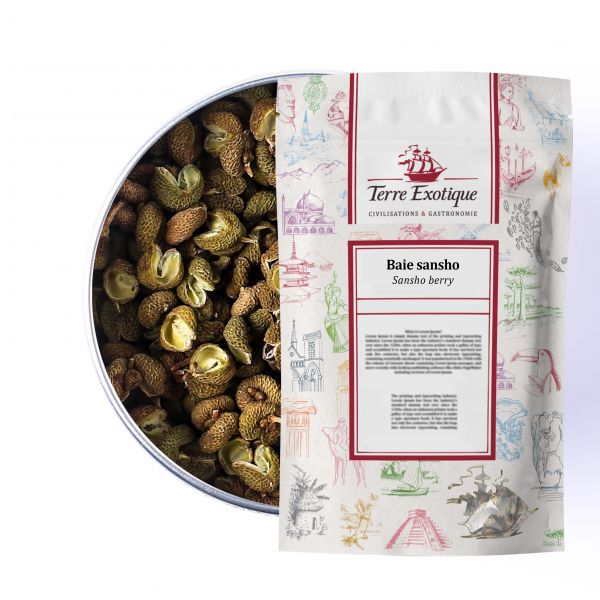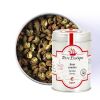







Origins of Sansho Pepper
Originating from Japan, Sansho berries are essential in traditional and authentic Japanese cuisine. Commonly called lemon pepper, they have been known since antiquity for flavoring offerings to the gods.
Harvesting Sansho Pepper
Sansho berries are harvested south of Kobe in Wakayama Prefecture on Honshu Island. The best time to harvest this berry is July-August. The berries are picked before maturity and dried, then the berry itself, which is as hard as wood, is removed to keep only the pericarp. It is the highly aromatic shell of the Sansho berry that constitutes the "cold" spice, meaning a spice that is both spicy and refreshing.
Aromas of Sansho Pepper
Its explosive taste of lemon, mint, lemongrass, and pepper offers a remarkable range of intoxicating sensations. Completely unique! Like its cousin the Szechuan pepper, it slightly numbs the palate. Very spicy, ultra-strong, this spice will leave you speechless.
It is on fish, especially grilled eels, or on semi-cooked meats, that Sansho pepper is most commonly used in Japan.
A true gift of nature, these extraordinary Sansho berries alone justify a trip to the land of the rising sun.
Culinary Uses of Sansho Pepper
Japanese people believe that Sansho pepper was already used in Japanese cuisine in the Jomon period (from 15,000 to 300 BC). At that time, Japan was inhabited by hunter-gatherers.
Today, the Japanese nickname the berries "SANAHO" or "HAJIKAMI." They use it in powder form to enhance a noodle soup, on grilled eel, or in a traditional mixture of 7 spices called "SHICHIMI."
Its delicate citrus scents and notes of mandarin leaves will perfectly harmonize with a sweet and savory preparation, a lobster tail or lobster, poached poultry, exotic fruit salad, or a moist chocolate cake.
In Japan, the local recipe is Kobe beef with Sansho pepper. Its spiciness electrifies foie gras. Its acidic flavor invigorates fish. Its freshness is magical on a duck breast gives a real boost to fruit salads.
We recommend crushing the Sansho berries using a mortar before use.
Sansho Pepper Beef Tataki, for 6 people:
Generously salt and pepper a small, tender beef roast, tied, at room temperature, with Sansho pepper, and sear it in a pan on all sides. It should be grilled on the outside, almost raw inside. Cut a large handful of ginger into matchstick-sized strips and sauté in butter over low heat for 10 minutes, stirring often.
With a good Japanese knife, slice the roast into thin slices in a dish. If the tataki releases juice, keep it for the sauce:
- 10 cl soy sauce
- 5 cl sesame oil
- 1 crushed garlic clove
- Drizzle the tataki with sauce
- Sprinkle with cilantro leaves, chives, arugula, crushed peanuts
- Arrange the strips of ginger.
Learn more about pepper
What is a "pepper"?
Piperology: the science that studies peppers
Learn more about the Zanthoxylum genus and its species
| Allergen | Absence |
|---|---|
| Native country | JAPON |
| Genus and botanical species | Zanthoxylum piperitum |
| Ingredients | Sansho berry |
| TRACES EVENTUELLES D'ALLERGÈNES | céleri, sésame, moutarde, fruits à coques. |
 Français
Français 



